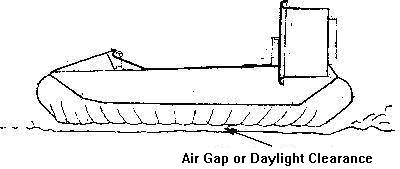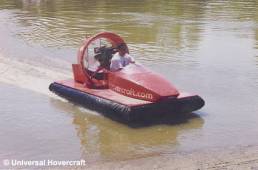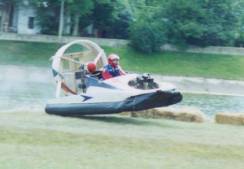
Figure 15-1: Air gap or daylight clearance in a hovercraft.
Image ©2005 DiscoverHover
DiscoverHover CURRICULUM GUIDE #15
PRESSURE AND LIFT
© 2005 World Hovercraft
Organization
| NAME | DATE |
Lift air, like other gases, is considered to be a fluid because it takes the shape of the container surrounding it. In the case of a hovercraft, the air takes the shape of the bottom of the hovercraft, the inside edges of the skirt, and the surface beneath the hovercraft. The fan that blows air under the bottom of the hovercraft keeps pushing more and more air below the hovercraft, thus increasing the pressure in the air cushion. The pressurized air cushion exerts a force on its container (the bottom of the hovercraft, the skirt, and the surface the hovercraft is resting on). When the force this pressurized air exerts on the surface grows to equal the weight of the hovercraft, it becomes buoyant (like a boat in water) and begins to float on air.
When a hovercraft hovers, it will lift as high as the skirtís designed shape will permit. Lift air begins to escape through the gap between the bottom of the skirt and the surface beneath. In order to maintain consistent pressure inside the air cushion, the gap will be large enough to keep the amount of air that escapes equal to the amount of air pushed in by the fan. This air gap between the skirt bottom and the surface, referred to as daylight clearance, ordiarily measures between 0 and 12.7mm [1/2 inch].

Figure 15-1: Air gap or daylight clearance in a hovercraft.
Image ©2005 DiscoverHover
Pressure is defined as the force exerted on a surface per unit area of the surface.
Pressure = Force / Area
P = F / A
In order to calculate the lift force of a hovercraft, we solve this equation for the force:
F = P × A
The lift force, therefore, is the air pressure inside the air cushion multiplied by the area enclosed by the hovercraft skirts.
|
Example 1: Solution: Area = Length × Width Now we can find the lift force by multiplying the pressure times the area. Lift force = Pressure × Area The DiscoverHover One hovercraft produces 1508 N [338.8 lb] of lift force and will therefore be able to support up to 1508 N [338.8 lb] of total weight and still hover. This means if the actual hovercraft weighed 450 N [101.2 lb], then it could carry 1058 N [237.6 lb] of people and cargo. |
|
Example 2: The pressure inside the air cushion of a DiscoverHover One hovercraft is 335 Pa [7 lb/ft2] when its volume is 2.24 m3 [79.28 ft3] at the temperature of 300 K [80 °F]. The height of the air cushion is 0.3 m [0.98 ft] from the bottom of the skirt. Assume that the air cushion is a closed system (even though the skirt of the hovercraft is open from the bottom) in the shape of a rectangular box and the surface area remains constant. What is the weight of the hovercraft? Assuming the air inside the air cushion behaves like an ideal gas, what is the volume of the air cushion if the pressure drops to 240 Pa [5.01 lb/ft2] at 300 K [80 °F]? Solution: W = P × A Now, since the air inside the cushion behaves like an ideal gas, we can use Boyle’s Law to determine the volume at 335 Pa [7 lb/ft2]. From Boyle’s Law we know: P = C / V We can calculate the value of C at 300 K [80 °F]. C = P × V At 300 K [80 °F] the volume of the air cushion can be given by Boyle’s law stated above, using the new pressure and the constant C we just calculated: V = C / P The new volume of the cushion would be 3.13 m3 [111 ft3]. |
In the case of hovercraft, there are two forms of pressure that can be measured: static pressure and dynamic pressure. Static pressure is the pressure of a stationary region of air, while dynamic pressure is the pressure of air that is in motion. Static pressure is what lifts the hovercraft. If you measure the pressure of the lift air cushion by placing a manometer (a device that measures pressure) just under the skirt, you will obtain a different value than if you were to measure the pressure further inside the cushion. This is because the air is moving rapidly out of the bottom of the skirt, so you could be measuring dynamic and static pressure at the same time. At the cushion center, the lift air is more static.
The DiscoverHover One hovercraft is an integrated hovercraft, which means that only one propeller is used to provide both lift and thrust air. Some hovercraft designs have separate lift and thrust systems. The sole purpose of the fan is to maintain the pressure inside the air cushion under the hovercraft. A multi-bladed fan is used for lift because it pumps pressure more efficiently than a propeller with only two blades. A separate propeller mounted on the back of the hovercraft is responsible for driving the hovercraft forward.
 |
 |
(a) Integrated type | (b) Separate lift and thrust |
Figure 15-2: Different lift and thrust systems
>Images ©2005 DiscoverHover
In an integrated hovercraft, the lift air is divided by a splitter, which is usually located at the bottom of the thrust duct, as shown in Figure 15-3a. Located directly behind the propeller, the splitter directs a portion (usually 1/3) of the propeller's total air supply down into the air cushion, which maintains pressure inside the cushion. The rest of the air is forced behind the hovercraft, propelling the hovercraft forward. A diagram of the various paths the intake air travels in an integrated type of hovercraft is shown below.

(a) Duct and splitter

(b) Flow of air in an integrated design
Figure 15-3: Basic working mechanism of a hovercraft
Image ©2005 Neoteric Hovercraft, Inc. (Courtesy www.neoterichovercraft.com)
Quiz Questions:
| ©2005 World Hovercraft Organization All rights reserved. Copies of this Curriculum Guide may be printed for classroom use exclusively by DiscoverHover registered members. This Curriculum Guide and all materials contained in the DiscoverHover web site are protected by copyright laws and may not be reproduced, republished, distributed, or displayed on any other web site without the express prior written permission of the World Hovercraft Organization. |